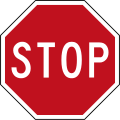A. Behind the line
A. Behind the line
B. Where you can see traffic coming in both directions
C. You don't need to stop if you can see nothing's coming
D. With the front wheels of your vehicle on the yellow line
 It is compulsory to stop at a stop sign. As you can see from the Land Transport (Road User) Rule 2004 below, where exactly you stop is a bit ambiguous:
It is compulsory to stop at a stop sign. As you can see from the Land Transport (Road User) Rule 2004 below, where exactly you stop is a bit ambiguous:
Part 4 (you can find the legislation here)
Stopping and giving way
4.1Giving way where vehicles are controlled by stop sign or give-way sign
(1)A driver approaching or entering an intersection on a roadway where the vehicles that are moving in the direction in which that driver is travelling are controlled by a stop sign at or near the intersection must—
(a)stop his or her vehicle before entering the path of any possible vehicle flow at such a position as to be able to ascertain whether the way is clear for the driver to proceed; and
(b)give way to any vehicles approaching or crossing the intersection from a roadway not controlled by a stop sign.
The rule states that you should stop where you can ascertain whether the way is clear. There is a yellow stop line at an intersection with a stop sign and, depending on the road conditions, weather conditions, angle of the sun, volume of traffic and if there are vehicles parked near the intersection, this could be on the line, in front of the line or behind the line. It's most likely not going to be 10m behind the line. You are allowed to stop at or behind the line and creep forward to get a better view.
If you are following a vehicle that stops, you should stop again after that vehicle has gone, even if you think you can see the way is clear from behind the vehicle in front. If you don't this might be viewed as breaking the law by the police, even though you may think you have a good view of the road. This is because the vehicle in front could have been obscuring your view, for example a driveway opposite the road, or other less visible road users.
If you are taking your driving test, some examiners will fail you if you don't stop for at least three seconds. Remember that you also need to indicate for at least three seconds when you are performing a manoeuvre.
An intersection will have a stop sign because it has inherently more danger than other intersections. If an intersection was safe to negotiate without stopping it would have a give way sign.